August 13, 2010
Air Date: August 13, 2010
FULL SHOW
SEGMENTS
Getting to the Bottom of Methane
View the page for this story
Scientists have discovered the permafrost beneath the East Siberian Arctic Shelf is melting, releasing large amounts methane into the atmosphere. Some say it could mean serious climate consequences, others say C02 is still the bigger problem. Host Jeff Young speaks with Dr. Matthew Reagan of the Lawrence Berkeley National Laboratory about the need to answer key questions before sounding the alarm about methane: how much and how fast? (05:50)
Building Green with Less Green
/ Jeff YoungView the page for this story
Host Jeff Young visits a super energy-efficient, solar powered house in Maine. Its owner uses technology he calls “state of the shelf,” rather than state of the art. The goal is a green house that’s as economically affordable as it is environmentally sustainable. (06:00)
Reforming Toxic Chemical Regulation
/ Bruce GellermanView the page for this story
There’s growing evidence linking industrial chemicals to chronic diseases and birth defects. Seventy-four billion pounds of chemicals are produced each day in the U.S. yet few of the ingredients have been evaluated for safety. Living on Earth’s Bruce Gellerman reports on attempts to overhaul how the nation regulates industrial chemicals. (09:30)
Note on Emerging Science
/ Bridget MacdonaldView the page for this story
Some animals use sticks, leaves or mud to build durable nests. The Tungara frog uses bubbles. Living on Earth’s Bridget Macdonald reports on how scientists are studying frog foam in order to make a similar material for medicinal use. (01:40)
The Sound of Solar
View the page for this story
If you’ve ever seen the aurora borealis, you’ve seen evidence of the solar wind - the constant stream of hot, charged particles flowing into space from the atmosphere of the sun. Now you can listen to it, too. Members of The Solar and Heliospheric Research Group at the University of Michigan are using the solar wind as musical inspiration. Host Jeff Young speaks with composer Robert Alexander and space science research fellow Jason Gilbert about how to make music from celestial data. (06:45)
Three Men and a Bike
/ Jessica Ilyse KurnView the page for this story
Bicycles burn calories, not carbon, so they’re considered among the cleanest forms of transportation. But most bikes are made of aluminum and steel which leave a large carbon footprint since the materials are mined and processed. Now, a group of young men have come up with a clean, renewable replacement: bikes made of bamboo. Living on Earth’s Jessica Ilyse Smith went to the Bamboo Bike Studio in Brooklyn, New York and has our story. (06:00)
Walden by Haiku
View the page for this story
IN 5-7-5: Henry David Thoreau’s Walden is one of the best-known works of American nature writing. The book includes images of nature, an emphasis on simplicity, a sense of aloneness, and the use of paradox - elements that are also present in haiku poetry. Noting these similarities, Penn State/Altoona Professor Ian Marshall took Thoreau’s prose and rewrote them into a series of haiku. He tells host Jeff Young talks about his process and why he decided to do this project. (09:40)
This week's EarthEar selection
listen /
download
Sounds of a lone adult right whale near Peninsula Valdez in Argentina.
Show Credits and Funders
Show Transcript
HOST: Jeff Young
GUEST: Matthew Reagan, Keith Collins, Jason Gilbert, Ian Marshall
REPORTER: Bruce Gellerman, Jessica Ilyse Smith
SCIENCE NOTE: Bridget MacDonald
[THEME]
YOUNG: From Public Radio International - this is Living on Earth.
[THEME]
YOUNG: I’m Jeff Young. We live in a sea of chemicals, some 60,000 compounds regulated by an antiquated law with an operatic name: TSCA.
WAXMAN: The Toxic Substances Control Act was adopted in 1976 and it has never been revised, but nobody thinks it's working, even the industry realizes the law needs to be revised.
YOUNG: Re-thinking our relationship with toxic chemicals. Also, we visit a green home that’s super-efficient, affordable, and stylish.
COLLINS: You know, some people think that to go green we should wear, you know, burlap bags and eat rocks, and I'm just not into suffering, you know? I think that if we put our minds to it we ought to be able to live very well, as well as protect the planet.
YOUNG: That and more this week on Living on Earth! Stick around.
[MUSIC: Boards Of Canada “Zoetrope” from “In A Beautiful Place Out In The Country” (Warp Records 2000)]
Getting to the Bottom of Methane
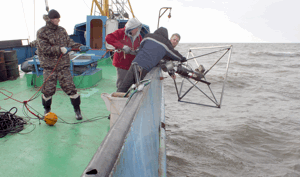
Scientists drop a tool into the ocean that allows them to record the sound of methane bubbling up from the seafloor. (Photo: Igor Semiletov, University of Alaska Fairbanks)
YOUNG: From the Jennifer and Ted Stanley Studios in Somerville, Massachusetts, this is Living on Earth. I’m Jeff Young. It’s an encore edition this week- we’ll hear some of our favorite stories from the past year- think of it as recycling.
Recent discoveries on the floor of the Arctic Ocean have raised interest and concern about methane and its role in climate change. A study in the journal Science found permafrost under the East Siberian Arctic Shelf is not so permanent. Some of it is melting and as it does, it leaks methane into the atmosphere. Previous studies found a similar phenomenon in the waters off of Norway.
Now this raises a troubling scenario, because methane is a powerful greenhouse gas.
If warming waters melt enough of these frozen hydrates of methane, it could lead to a feedback loop amplifying climate change. Dr. Matthew Reagan at the Lawrence Berkeley National Laboratory is working on models of these methane releases. Welcome to the program.
REAGAN: Hello, Jeff.
YOUNG: So, why are we concerned about these releases of methane from the oceans?
REAGAN: Well, recently scientists have realized that vast quantity of methane that exists in the oceans and in the permafrost in various forms. And as the climate warms the oceans warm in concert and various processes may cause this methane to enter the ecosystem. First in the oceans and then possibly into the atmosphere.
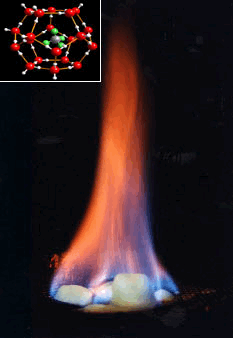
Frozen methane on fire. (United States Geological Survey)
YOUNG: So this most recent study looked at the East Siberian Arctic Shelf, which I guess is fairly shallow water. But that’s not the only spot where scientists are finding this, right?
REAGAN: That’s correct. In fact, about a year and a half ago, an expedition in the Bering Sea Svalbard area found a series of methane plumes erupting from the shallow continental shelf west of the island of Spitsbergen. And what was interesting about these plumes was not only their existence and their size, but that we see plumes erupting out of the sea floor in some 390, 400 meters of water and reaching high up into the water column.
And, in the case of the East Siberian Arctic Shelf we also see that the methane is passing through the water column and reaching the atmosphere. Previous studies thought that much of the methane would be oxidized in the oceans and release to the atmosphere would be minor. But now we’re seeing releases that are both large enough and shallow enough to let that methane get into the atmosphere.
YOUNG: Give me a sense of how much methane we’re potentially talking about?
REAGAN: Various numbers have been thrown out, but we estimate that the quantity of methane in gas hydrates exceeds, possibly by a factor of two, all of the carbon in developed and undeveloped fossil fuel reservoirs.
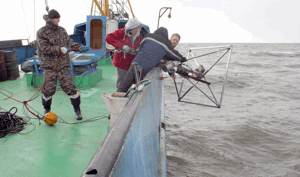
Scientists drop a tool in the ocean that allows them to record the sound of methane bubbling up from the seafloor. (Photo: Igor Semiletov, University of Alaska Fairbanks)
YOUNG: So, do we know that this is a new phenomenon, that it really is melting because the seas are getting warmer, or is this something that maybe has been going on for a long time and we just never noticed it?
REAGAN: You know, we don’t know. In the Bering Sea Svalbard area the region had experienced warming of the ocean in recent times that’s documented. However, these observations have only been made recently. So what we have to do is often supplement these observations with modeling to try to figure out whether these processes have the potential to cause methane release in this form, or if perhaps the methane is not tied to say, recent temperature change and is something that’s been chronic and been happening for awhile.
YOUNG: So tell me about methane as a greenhouse gas. How does it compare to carbon dioxide in its ability to trap heat?
REAGAN: Well, methane, depending on how you assess its impact can be 20 to 40 times as powerful a greenhouse gas as carbon dioxide. However, methane’s residence time in the environment is much less than that of carbon dioxide. Methane oxidizes to carbon dioxide on time scales of decades, while carbon dioxide can be with us for thousands of years. The key to understanding the effect of methane is knowing the rate of release into the environment. Also to know that rate of release we need to understand the fate of the methane as it’s released.
YOUNG: So if we do get a big burp of methane all at once that might be one of what we call a -- I guess a feedback loop, right?
REAGAN: That is what has been hypothesized and what scientists have been concerned about for many years. When you look at the sheer size of the methane reservoir there is a reason to be concerned. However, I don’t think we should be scared and I don’t think we should be sounding alarms just yet. What we need to do is do the work and study the situation. Scientists are just starting to quantify this.
The observations off of Spitsbergen, the recent discovery in the East Siberian Arctic Shelf, these are key because they are the first real evidence that this release may be happening now, and this is motivating scientists to study the problem even harder.
YOUNG: So if we’re just now starting to get a handle on the mechanism of this potential feedback loop that means that this sort of stuff has not yet been fed into climate modeling for what the impact of climate change might mean?
REAGAN: No, and in fact, our project here at Berkeley Lab in collaboration with Los Alamos and Lawrence Livermore Labs is to track methane from the sediments, from release from hydrates in the sediments up into the ocean water column, study how it affects of ocean chemistry, assess whether that methane can be released into the atmosphere, and if so, how much? This data will all go into climate models and tell us whether methane is truly a concern.
YOUNG: Dr. Matthew Reagan at Lawrence Berkeley National Laboratory. Thank you, sir.
REAGAN: Thank you very much.
Related links:
- For more about recent discoveries of methane releases, click here.
- For more about Matthew Reagan’s work, click here.
- To learn more about methane releases on the West Spitsbergen continental margin, click here (subscription only).
- Click here to learn more about methane and climate change.
[MUSIC: Green Barn - Jeremy Udden “Curbs” from Plainville (Fresh Sound New Talent 2009)]
Building Green with Less Green
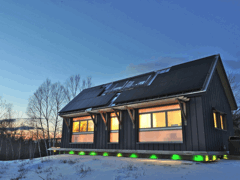
The green lights on the bottom of the house show when it’s producing more energy than it needs (glowing green) or using energy from the grid (glowing red).
YOUNG: Green housing is all the rage, but the price tags on a lot of those energy-saving homes, could put a household in the red. Well, one pioneering homeowner says green living can be more affordable and accessible. Keith Collins, a retired physician in Maine, brought together top designers and architects to help him build what he calls the Bright Built Barn. When I called to arrange a visit, Dr. Collins told me to look for the tight little house on a hill, with a south-facing roof. So I hit the road to mid-coast Maine.
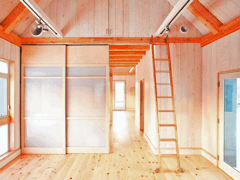
Over its first year, the house has generated five thousand more kilowatt hours from solar panels than it used.
[MUSIC]
[KNOCKING DOOR; DOOR OPENING]
YOUNG: Hello, there!
COLLINS: Hi, Jeff - Welcome to Maine.
YOUNG: Thanks for having me.
COLLINS: Well, thanks for coming up and I’d love to show you Bright Built Barn, and it’s a beautiful sunny day, and we’re making lots of electricity.
YOUNG: Dr. Collins has solar power in his place and many of the things you’d expect from energy-efficient design. Double thick insulated walls, triple paned windows and obsessive weatherproofing. But it also has something you might not expect – charm. Lots of natural light, pretty pine floors and exposed spruce beams reaching up to a high vaulted ceiling.
COLLINS: You know, some people think that to go green we should wear burlap bags and eat rocks, and I’m just not into suffering, you know? I think that if we put our minds to it we ought to be able to live very well, as well as protect the planet.
YOUNG: Let’s take a walk in here and talk a bit about your lighting, because I know that’s another area where we tend to use a lot of energy.
.gif)
Energy ratio for the green house. Energy production is green and energy consumption is in red, while the blue shows the energy flow to the grid.
COLLINS: If you look over here you see these lights are what are called LED lights – they’re light emitting diodes. They’re basically little computer chips that give off light. Each of these fixtures is using five watts and giving off the same amount of light as a 75-watt incandescent bulb, so there’s a 15 times more energy efficient.
[KNOCKING SOUNDS]
YOUNG: We climb above the moveable birch panel walls to the loft, for a look at the solar system: 30 voltaic panels provide electricity and solar thermal tubes heat water, which also heats the house. Dr. Collins likes the medical metaphor. He calls this the heart of the house. And in the corner, is the brain: a metal box with a digital display.
COLLINS: This is what I call my report card. Here it says – and this is from the day we turned on all the systems – how many kilowatt-hours have we consumed here in the barn, and it’s 1,247-kilowatt hours.
YOUNG: That’s for like a year, more than a year?
COLLINS: Yeah, that’s a year. However, we produce 6,342-kilowatt hours in that year. Giving us a net positive of 5,094-kilowatt hours as of today October 17, 2009.
YOUNG: So, your meter, your meter spins backwards?
COLLINS: Absolutely. And it spins backwards a lot. You know, basically any really sunny day, my meter’s spinning backwards.
YOUNG: And the grid, it’s your battery?
COLLINS: The grid is my battery. In other words, what we do is we put the energy out on the grid when we’re making excess, and when we’re not making excess, and we’re consuming more than we make, we draw from the grid.
YOUNG: There’s some information technology at work here to make everything play well together. But, by and large, this is low-tech, this isn’t high-tech?
COLLINS: And that’s what we tried to do. We were aiming for the state of the shelf, not the state of the art. A real goal in building this was not to build something that would be Buck Rogers, high-tech, something you needed a degree in astrophysics to run – this was something where anybody could have a house like this.

The green lights on the bottom of the house show when it’s producing more energy than it needs (glowing green) or using energy from the grid (glowing red).
[WALKING DOWN STEPS]
YOUNG: Putting clean electrons back into the grid is also part of Dr. Collins’ plan to make the house truly carbon-neutral. He kept tabs on the CO2 emissions from construction, even using local wood, and keeping the house small – just 30 by 24 feet – he still put 500 metric tons of CO2 into the atmosphere. Collins calls that his house’s carbon debt and he can only pay it off if the house lasts.
COLLINS: Everything in the barn is designed to last 200 years, except me. [Laugh] I’m not going to last 200 years, which means I’ve got to build something not just for me, I’ve got to build it for all those generations after me who will come to use it and have to feel that it is functional, but they also have to feel that it’s beautiful.
YOUNG: So, aesthetics matter. If it’s going to be green, it’s going to be good looking, too?
COLLINS: Absolutely, because, in fact ugly houses get smashed down. So, what we need to do is we need to make a space, which is beautiful so that people will take the energy to adapt it to their needs. We are then offsetting the carbon that we put off into the atmosphere to build it.
YOUNG: You’re paying back your carbon debt, little by little.
COLLINS: Absolutely, little by little, and just to give you some numbers: 5,000. Well, if you do the math, those 5,000-kilowatt hours equate to about five metric tons of carbon dioxide.
YOUNG: Five tons down, and 495 to go.
COLLINS: 495 to go, right? So, we’ve only got 99 more years to go, and we’ll have paid off our debt. We’re already planning the party.
YOUNG: Well, Dr. Keith Collins, thanks very much. It’s a great pleasure.
COLLINS: It was great to see you, thanks for coming by.
YOUNG: Now, about the money…Dr. Collins says a house like this one, with the solar system, would be about $220,000. That sounds like a lot, but averaged over the life of a 30-year mortgage, it’s about the same cost as normal, inefficient construction. And Dr. Collins will probably never have to pay another power or heat bill. You can see pictures and plans for his Bright Built Barn at our website: LOE dot org.
Related link:
Click here for a diagram of a green house
[MUSIC: Charlie Hunter, Chinna Smith, Ernest Ranglin “Island In The Sun” from “Earth Tones” (Breadfruit Music 2005)]
YOUNG: Coming up – a new attempt to overhaul the nation’s decades old toxic chemicals law. Keep listening to Living on Earth.
Reforming Toxic Chemical Regulation
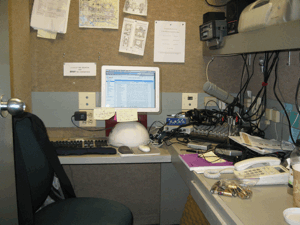
Living on Earth's Washington studio on Capitol Hill. (Photo: Bruce Gellerman)
YOUNG: It’s our recycled edition of Living on Earth – I’m Jeff Young.
According to the Environmental Protection Agency, 74 billion pounds of chemicals are produced or imported into the United States each day. That's more than 240 pounds of chemicals for every man, woman and child in the country. And that doesn't even include chemicals used in drugs, foods, fuels or pesticides.
The federal law that’s supposed to protect people and the environment from industrial chemicals is more than three decades old. And consumer and environmental groups, the EPA, even manufacturers agree—the current regulations are long over due for reform. Living on Earth's senior correspondent Bruce Gellerman reports from Washington.
GELLERMAN: In the Living on Earth broadcast studio on Capitol Hill I'm surrounded by things made from chemicals. The walls and floor are carpeted, the ceiling is insulated tile, my desk is painted, I've got a plastic bottle, my pens and printer are filled with ink, there’s a pile of alkaline batteries. And just look around. Chances are you too are also surround by products made with industrial chemicals.

LOE's Washington Studio on Capitol Hill (Photo: Bruce Gellerman)
WALLS: Our products, our industry’s products touch 96 percent of all manufactured goods.
GELLERMAN: That's Michael Walls—Vice President of Technology and Regulatory Affairs with the American Chemistry Council. It’s a trade group representing the nation’s largest chemical manufacturers.
WALLS: You're talking about an industry that is vital for the national defense. It's vital to the health and safety of all Americans. You're talking about the solutions to some of our global problems like climate change, you know, reducing CO2 emissions is fundamentally a chemistry problem.
GELLERMAN: There are over 82 thousand industrial chemicals registered for use in the United States and that number is increasing by about 700 new chemicals a year—that concerns health advocate Andy Ingrejas.
INGREJAS: It’s true that chemicals are used in almost everything. There’s lots of benefits from chemicals. But I think for most people that’s all the more reason why we should know what’s going on with them.
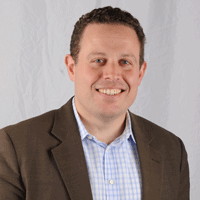
Andy Ingrejas is Campaign Director of Safer Chemicals Healthy Families (Photo: Safer Chemicals Healthy Families)
GELLERMAN: Ingrejas is campaign director of Safer Chemicals, Healthy Families. It’s a coalition of 200 organizations campaigning for changes in the federal law regulating industrial chemicals.
INGREJAS: Chemicals on the market right now are effectively unregulated. The federal government has not reviewed their safety and said, ‘oh okay…this is okay to be used in all these ways.’ They have not done that. It’s nothing like what we do for drugs.
GELLERMAN: For drugs, manufacturers must prove to the Food and Drug Administration that their chemical compounds are safe.
But under the federal law known as TSCA—the Toxic Substances Control Act—industrial chemicals are automatically considered safe. It’s up to the government to prove they’re not. Senate Democrat Frank Lautenberg of New Jersey has proposed a bill that would radically overhaul TSCA. California Democrat Henry Waxman is leading the effort in the House.
WAXMAN: The Toxic Substances Control Act was adopted in 1976 and it has never been revised, but no one thinks it’s working, even the industry realizes the law needs to be revised.
DOOLEY: Clearly we’re committed to the safe use of our products.
GELLERMAN: Former Congressman Calvin Dooley is head of the American Chemistry Council.
DOOLEY: We think TSCA has been working very well, but we also recognize that after 30 years that there’s opportunities to even enhance it’s effectiveness and utilizing some of the new science and technology to even do a more accurate assessment and comprehensive assessment of the safety of chemicals.
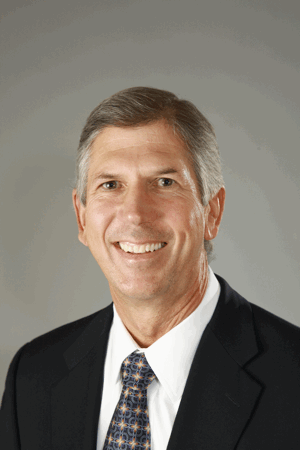
Calvin Dooley is President and CEO of The ACC. (Photo: Calvin Dooley)
GELLERMAN: This represents a major shift in the Chemistry Council’s position—a reaction to growing public concern over environmental toxins. Previously, the Council advocated voluntary measures, but in recent months, congressional and EPA staffers, advocacy groups and industry representatives have been meeting to work out the many technical details for overhauling TSCA. Michael Walls of the Chemistry Council has participated in those sessions.
WALLS: I think that’s what’s remarkable about this issue is that at this stage in the discussion there is a consensus that maybe we can do something. But it’s in the details where the hard work still needs to be done.
GELLERMAN: The devil is in the definitions. Right now, in order for the government to regulate a chemical the EPA has to prove it poses—quote—“an ‘unnecessary risk’ to people or the environment.” Jane Houlihan, vice president for Research at the Environmental Working Group says that’s the first thing that needs to be changed.
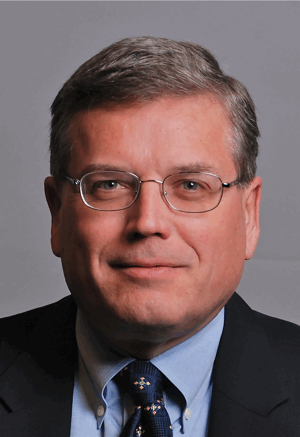
Michael Walls is Vice President of The American Chemistry Council (Photo: American Chemistry Council)
HOULIHAN: Under the current system chemicals are innocent until proven guilty and the new proposals would flip that, there would be a burden of proof. Industry would need to provide proof to EPA that the chemicals are safe enough to use.
GELLERMAN: The new standard would require companies to demonstrate—quote—“a reasonable certainty of no harm.” That’s the same standard the federal government now uses to regulate pesticides. The American Chemistry Council agrees the burden of proof should be on manufactures, but president Cal Dooley cautions that adopting the “no harm” standard could hamper innovation.
DOOLEY: You know, I think the question’s now is really in terms of, how do you define that standard? And I think that’s the public policy challenge that we face…. is: what is that risk standard that we’re willing to accept?
GELLERMAN: And how is that standard set and met? Today, the United States is the only developed country in the world that does not require a chemical maker to submit safety data before production. But without the data, how can the EPA determine risk or harm? Again Jane Houlihan of The Environmental Working Group:
HOULIHAN: One thing we have in federal law now is a requirement for companies to submit studies—that they happen to do—there is no requirement to submit studies. If the company determines that that study indicates a significant risk to human health or the environment. Now that’s the company’s interpretation of whether that is a significant risk. If they say, “yeah we think it’s a significant risk” then they submit that study to the EPA. But it’s their discretion.
GELLERMAN: Right now, the EPA has just 90 days to review a new chemical before a company can start selling it. And in only 15 percent of those products does the manufacturer provide the agency with any health and safety studies.
HOULIHAN: It’s such a weak law that EPA has used it to get off the market or set restrictions for only five chemicals or chemical families in the history of the law. They’ve only required testing for about 200 chemicals or chemical mixtures. Now compare that to the 82 thousand chemicals that are registered for use in the U.S. and you see that they are only able to tackle a tiny fraction of what’s on the market.
GELLERMAN: The last time the EPA tried to ban a chemical under TSCA was 1991. That was asbestos, a known carcinogen, responsible for nearly ten thousand deaths a year in the United States. Asbestos is still used in consumer products. That’s because according to federal law the EPA must use the least burdensome option, of all other possible actions, to reduce risk, so banning asbestos is simply not an option.
The proposed Safe Chemicals Act would require companies to provide basic health and safety data for each chemical they produce. It would also create a list of the most dangerous products on the market and give the EPA expanded powers to regulate them. Congressman Henry Waxman wants to go even further. He says manufacturers should have to show how exposure to chemicals affect people in real life.
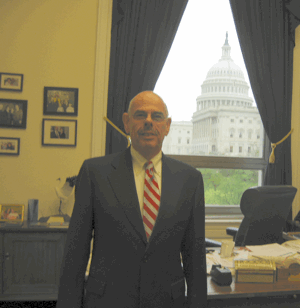
Congressman Henry Waxman (Photo: Bruce Gellerman)
WAXMAN: I think the approach that we often take that we’re going to look at chemical-by-chemical leads us nowhere. We’ve got to get it on a much faster time frame and look at not just one chemical but the impact of a number of different chemicals in combination.
GELLERMAN: Researchers say environmental exposure to chemicals may be responsible for up to 35 percent of asthma cases, ten percent of cancers, and 20 percent of neurological disorders. But which chemicals? What products? Under current law manufacturers can claim confidentiality; they can keep their ingredients secret. Congressman Henry Waxman:
WAXMAN: People who buy curtains or other products that have chemicals in them have no idea that they may be exposing themselves and their loved ones to something that could cause cancer or other disease. So there is no rationality to the regulation at the federal level to protect the public, to make sure that industry has the rules under which they must operate and to make particularly clear that we want to watch out for the interests of our children who are even more susceptible to toxic chemicals.
GELLERMAN: Proposed updates to the Toxic Substances Control Act would do just that. In the future, chemical companies would have to consider the affects their products have on especially vulnerable populations including women, children, people of color and those living near chemical factories. After decades of failed attempts, Congress is now putting the overhaul of TSCA on the fast track. Congressman Waxman hopes the house will vote on it before Memorial Day, and Cal Dooley, the head of the American Chemistry Council is cautiously optimistic.
DOOLEY: You know when you look at the political environment today, you look at the complexity of this issue is that the stars would have to align in order to see action, I think, this year.
GELLERMAN: But many states and cities are not waiting for the stars to align. In the absence of federal action a growing number of local governments are moving to restrict, and in some cases ban chemicals the EPA now lacks the ability to effectively regulate. For Living on Earth. I’m Bruce Gellerman.
[MUSIC: John Ellis “Three Legged Tango In Jackson Square” from Dance Like There’s No Tomorrow (Hyena Records 2008)]
Just ahead – the sounds of solar. But first this Note on Emerging Science from Bridget MacDonald.
Note on Emerging Science
[SCIENCE NOTE THEME]
MACDONALD: Think “foam” and your mind may wander to the melt-in-your-mouth topping on a cappuccino, but for some frog species, foam is a tough, protective shield for their young. Now researchers are trying to replicate frog foam for medicinal use.
The foam nests made by Túngara frogs in Central America may look delicate, but they’re known for their strength: they withstand high heat, bright sunlight, and bacteria, and stay intact until the tadpoles inside are ready to break free.
Researchers at the University of Glasgow are studying footage of the frogs to figure out how these small amphibians create such durable nests.
They discovered that the male frog collects a special fluid from the female, then kicks his legs up and down in short spurts to turn the liquid into a ball of bubbles. As the foam takes shape, the frog delicately adds the eggs, like a chef folding ingredients into cake batter.
The frog whips up more foam to put the finishing touch on the nest, kicking his legs about 200 times during the entire process.
Scientists are planning to use a similar technique to develop an anti-bacterial foam to treat burn victims. And it’s likely the synthetic version won't require kicking. That’s this week’s Note on Emerging Science. I’m Bridget Macdonald.
[END SCIENCE NOTE THEME]
Watch a male frog building a foam nest.
The Sound of Solar
YOUNG: If you’ve ever been to the far north, you may have seen the aurora borealis, those dancing, leaping lights in the northern sky. What we see in the northern lights is the effect of the solar wind. But we haven’t been able to hear those electrically charged particles streaming through space from the sun. Until now:
[MUSIC: drumbeats, whooshing sounds, and vocals]
YOUNG: The men behind this music are Jason Gilbert, a research fellow in space science, and Robert Alexander, a composer and media artist. They’re part of the Solar and Heliospheric Research Group at the University of Michigan. Welcome to the program!
GILBERT: How are you doing?
ALEXANDER: Hello.
YOUNG: Jason, what is that we were listening to?
GILBERT: What you were hearing was data from the advanced composition explorer, the ACE spacecraft. It’s measuring the solar wind. It’s essentially a stream of numbers that are coming down, which give us information on the temperature, the density, the charged state of the atoms in the wind.
YOUNG: What is solar wind?
GILBERT: Solar wind is essentially the atmosphere of the sun as it expands out into space. It goes streaming by the Earth very fast, and we catch it with our instruments, we measure what it is, what it’s made of, where it’s coming from, how fast and how hot it is.
YOUNG: So, obviously, pretty important to study this, but why is it important to take that data and turn it into music?
GILBERT: We wondered if there was a chance that there were things in the data that we just weren’t seeing as we look at it visually. Perhaps there was some pattern or some artifact that we could hear audibly instead. And so, we decided to sonify our data just to see if there was some other interesting piece of the puzzle that we could work out.
YOUNG: And Robert, that was your job, to take this raw data and make it into music. Where do you even start with that?
ALEXANDER: Well, I think that the things I noticed right off the bat just looking at the data is that some things were changing very rapidly – you’d get this really chaotic, sort of turbulent behavior with some of the data entries, while other points of data were happening much more smoothly. And some of the data points, such as the speed of helium as it was moving by the satellite. I was thinking that this would translate directly to something that might be similar to the sound of wind blowing here on earth.
[WINDY SOUNDS]
ALEXANDER: I thought, well, what does wind sound like in our ears, and I thought that, hey, the pitch of wind as it goes by is in part determined by the speed at which it goes by. So that’s the approach that I took.
YOUNG: So this almost tribal drum beat that we hear…
[RAPID, RHYTHMIC BEATS]
YOUNG: What is that in terms of the data?
[BEATS CONTINUE]
ALEXANDER: So, that’s a grandiose metronome. They’re actually representing the rotation speed of the sun on something… it’s known as the Carrington rotation.
YOUNG: And the swelling, sort of, symbol crashes?
[SOUND LIKE SYMBOL CRASH WITH VOCALS]
ALEXANDER: So, you’ve got this whooshing sort of sweeping sound and that relates directly back to the helium velocity and density.
YOUNG: And then the sort of constant tones, almost like a choir or a string section – what’s that?
[SOUND LIKE SINGING OR HUMMING]
ALEXANDER: So, I actually recorded my sister, Amanda Alexander, and I layered her voice such that at different charge states of carbon the prevalence of different layers of her voice changed just based on the charged state.
YOUNG: So, what we’re actually hearing here is the carbon in different charged states, the helium, and the speed that the sun is doing all this, right?
ALEXANDER: That’s correct.
YOUNG: And it comes together like music. It’s amazing.
ALEXANDER: [Laughs] Yeah.
[SOLAR WIND MUSIC CONTINUES]
YOUNG: And your – what it’s all about – your subject matter here is, it’s the sun. You’re giving voice to the sun, essentially.
ALEXANDER: Yeah, the source of all life on Earth. It’s pretty humbling to have that as source material.
YOUNG: Jason, is there a scientific benefit for this, or is this purely art, or does this affect the way you view what you study now?
GILBERT: In its current stage, this is purely an artistic production, but one of the things that we envision is perhaps having a graphical interface on your screen where you can check a box to turn on the carbon, or turn on the iron, or see how much this element is compared to this one. If we can make it an interactive tool like that, a researcher can use it find the science that they’re most interested in.
YOUNG: And does the finished product sound anything like what you had imagined when you first thought this up?
GILBERT: To be honest, I didn’t know what to expect. When we first started this I didn’t know if it was just going to sound like dropping a handful on needles onto a piece of steel. You know, random noise everywhere, but when we first started to listen to what Robert had been able to sonify, we were able to recognize, oh, that was a coronal mass ejection that just went by; oh, I can hear the wind getting faster here.
And the first time he showed it to us, we actually had the data on the screen, so we were watching it go by and so we knew what was coming, and then when it went by we knew how to recognize it in the future. So it turned out to be much more than what I expected.
YOUNG: And Robert did this end up sounding like what you thought it might sound like when you started out with that stream of data?
ALEXANDER: When I first started out I was extremely aware of wanting this data to be scientifically accurate, so most of my sonification work was extremely restrained and it sounded like really simple tones, and the scientists they kept prodding me like really, be more adventurous, and take more risks here, and really go out and try using a beat rather than a metronome.
YOUNG: And Jason, has this affected the way you now look at your data, listen to your data, the kind of questions you might ask of the data?
GILBERT: I think this is definitely given me a new appreciation for how things work out in space. You know, we can watch our satellites and see visually how the solar wind affects them and how this space weather affects them, but to hear it sort of gives it a new dimension, one that I hadn’t considered before. It’s opened my mind.
YOUNG: Jason Gilbert and Robert Alexander who collaborated on putting the solar wind to music. Thank you both very much.
GILBERT: Thank you.
ALEXANDER: Thank you so much for having us.
Related links:
- The Solar and Heliospheric Research Group at University of Michigan.
- Composer Robert Alexander’s website
[MUSIC: “Music From The Sun”. Music was produced and composed by Robert Alexander]
YOUNG: In just a minute- a few shortcuts to Walden- stay with us at Living on Earth.
[MUSIC: Medeski, Martin, and Wood “Jean’s Scene” from “Radiolarians III” (Indirecto Records 2009)]
Three Men and a Bike

Bamboo—the raw material to make bicycles in Bamboo Bike Studio—lies on a worktable beneath a finished product. (Bamboo Bike Studio)
YOUNG: You’re listening to a recycled edition of Living on Earth. I’m Jeff Young. When it comes to clean, inexpensive and healthy transportation, bikes are hard to beat. But since they’re typically made of steel or aluminum, which go through a lot of processing, bicycles can still carry a sizeable carbon pedal print. In Brooklyn, three men are taking an ecological approach to building bikes. We sent Living on Earth’s Jessica Ilyse Smith to give it a spin.
[SOUNDS OF RIDING ON COBBLESTONE]
SMITH: Rickety, jolting, awkward, riding a steel bike on a cobblestone road is a tricky balancing act. I huff and puff alongside Sean Murray, who moves with ease on his bike made of bamboo.
MURRAY: One of the nice things about the bamboo frames is that they drink up all of the vibrations in the road. So right now I’m not sharing your suffering.
SMITH: [Laughing] Why is that?
MURRAY: It’s because the bamboo itself is a composite material and it’s got these really strong fibers that are as rigid as steel. Those fibers are set in a matrix of very soft and supple bone, so you can ride over cobblestones like these and not really feel it.
SMITH: Bamboo bikes are Sean’s specialty. For the almost two years he’s been working along with two friends at their Bamboo Bike Studio in Brooklyn.
[SOUNDS OF CARS PASSING ON COBBLESTONE]
MURRAY: Always crazy traffic…go up and make a right.
SMITH: On the way to the studio, Sean’s bike draws a lot of attention. Heads turn as we come upon a blocked street where a commercial is being filmed.
MAN: Your bike’s made out of bamboo?
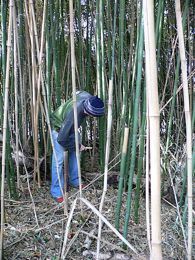
Marty Odlin harvesting roadside bamboo in New Jersey. (Bamboo Bike Studio)
MURRAY: Yea!
MAN: Can I pick it up?
SMITH: A crewmember notices how light the bike is – weighing less than 20 pounds.
MAN: Nice, that’s cool…I like that!
[SOUNDS OF OPENING THE STUDIO DOOR]
SMITH: The one-room bike studio has high ceilings, and unfinished walls. On the right bamboo frames in progress are mounted at workstations. To the left floor-to-ceiling shelves are filled with different types of bamboo.
MURRAY: This is our bamboo, which comes from the tri-state area. This piece right here is from Staten Island. This retired firefighter gave us a call and then me and him chopped it down in his backyard.
SMITH: Bamboo grows quickly and is invasive, so there’s no shortage of the plant – even in the urban northeast. The team constantly fields calls from homeowners offering up backyard bamboo. Justin Aguinaldo designs the sleek bamboo bike frames. He uses special tools like a Japanese pull saw – a thin blade that resembles an icing spatula.
AGUINALDO: Bamboo has a really tough silica outer coating and it dulls blades really fast. And if you use a regular saw it’ll also be more prone to splitting.
.jpg)
Justin Aguinaldo shows off finished bamboo bikes. (Bamboo Bike Studio)
SMITH: Justin hands me the saw and the bamboo and he and Sean nod at me expectantly.
[SOUNDS OF SAWING BAMBOO]
SMITH: I’m surprised at how easy it is to cut the bamboo. Sean says it’s because the plant has been treated.
MURRAY: After we harvest the bamboo then we do a treatment process that strengthens it and takes it from a dead plant into something that you can build a bike out of.
SMITH: The bamboo is heated until it’s dried, which reduces the chance of infestation and rot. No chemicals are used; it’s heat that turns the fresh green bamboo to a baked golden brown. The team won’t disclose the specifics of the process while they’re still perfecting the technique. But, Justin says it’s sustainable.
AGUINALDO: It doesn’t take a lot of energy, which is really nice because not only does it conserve energy but it also makes it feasible for someone in a developing country or a non-industrialized country to actually build this bike on their own.
SMITH: That’s the major goal of this project. The Bamboo Bike Studio has paired with Columbia University’s Earth Institute to bring their technology to Ghana.
AGUINALDO: We’re trying to work with the tools they would have to work with and figure out a way to do it so that it’s scalable, so that it’s doable, you know is it possible for a human being with their own two hands and a few tools to actually do this.
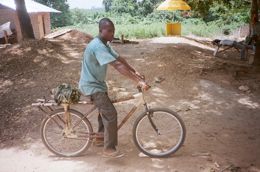
A man in Ghana test rides a bamboo bike. (Bamboo Bike Studio)
SMITH: For Ghanaians, and others in the developing world, bikes are a good form of low-cost transportation. Marty Odlin is the third member of the bamboo bike team. He recently returned from Ghana and says bikes can give people access to jobs, food, and hospitals.
ODLIN: I had a lot of people tell me what a difference it would make for them to have a bike.
SMITH: He looks forward to not only providing people with transportation, but also to creating bikes that are inexpensive and produced locally.
ODLIN: An average steel bike shipped in from China is roughly 100 dollars and in a large-scale factory we project that we’ll be able to sell these at a profit for about 50 dollars a bike.
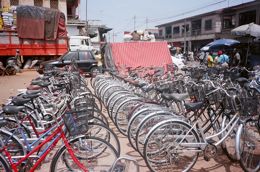
Expensive metal bicycles for sale in Ghana. (Bamboo Bike Studio)
SMITH: This reduction in cost could make a difference in Ghana, where the average per capita income is barely over 700 dollars a year. There’s a lot of bamboo in the country and using local materials could help fuel a bike-building economy. But, to Justin there are other reasons why he uses bamboo.
AGUINALDO: That question should be asked for all materials. Because then the question should be why steel…why is that the go-to all of the time?
SMITH: He says treated bamboo is as strong as steel and will hold up better on unpaved roads common in developing countries. On weekends, Sean, Justin and Marty run workshops in New York to teach others how to build their own bamboo bikes. The classes aren’t cheap – they’re over 900 dollars but the proceeds support research on how to build strong and easy-to-make bikes in developing countries. Students at the workshops learn more than just bike craftsmanship they also gain an awareness of the origin of materials.
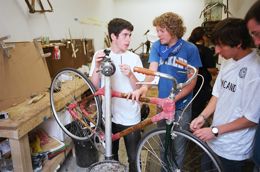
Sean Murrary (in blue) helps students work on a bike. (Bamboo Bike Studio)
MURRAY: Our tubes just grow out of the ground. So, just in the two days when you actually take the raw materials and put them together in such a way to make something so useful as a bicycle, it’s something that will then color the way that you look – not just at bicycles – but at every product.
[SOUND OF DOOR SLAMMING]
SMITH: I leave the bamboo bike squad to get back to Manhattan.
[SOUND OF SUBWAY]
SMITH: On the subway I look around me. After an afternoon with the Bamboo Bike Studio guys I can’t help but think about where the glass, the steel and plastic come from. And I wonder if they could be replaced with something more sustainable. Perhaps the transit system can start simply…bamboo seats anyone?
[SUBWAY CHIMES AS DOOR CLOSES]
SMITH: For Living on Earth, I’m Jessica Ilyse Smith in Brooklyn, NY.
[SOUNDS OF TRAIN PULLING AWAY FROM STATION]
Related link:
Click here for more about the Bamboo Bike Studio.
Walden by Haiku
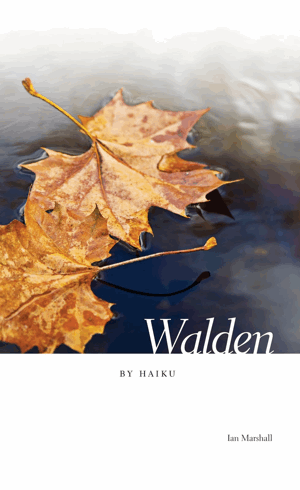
Professor’s Marshall’s new book that rewrites Thoreau’s Walden in haiku form.(Photo: Ian Marshall)
YOUNG: Henry David Thoreau's "Walden," published in 1854, is an acknowledged classic of American literature and one you probably know well. But you've probably not heard "Walden" quite like this. It's a new version by Penn State-Altoona English and environmental studies professor, Ian Marshall. Hello, Professor Marshall.
MARSHALL: Hello!
YOUNG: Professor Marshall, I'm hoping you can start us off by reading an excerpt from your "Walden".
MARSHALL: Okay, I'll keep it brief:
If I could ever find the twig
THE twig
The robin sits upon.
And you might notice that takes the form of a haiku.
YOUNG: A haiku? And the book is, "Walden by Haiku."
MARSHALL: Yep. What I did in the book is I have some haiku that I extracted from the text of "Walden."
YOUNG: And these are the actual words from Thoreau that you've taken and sort of made them more spare?
MARSHALL: Yeah.
YOUNG: Why haiku? What is it about the aesthetic of haiku that you find in Thoreau?
MARSHALL: Well, let us count the ways! First, there's the aesthetic of simplicity, simplicity of language, simplicity of theme, simplicity of lifestyle. There's the focus on the seasons. Some say that haiku is not so much a kind of nature poetry, but a poetry specifically about the seasons.
And of course that's the organizing principle of "Walden."
There's a reliance on images of nature as Thoreau goes through "Walden" it's more and more focused on images of nature with less and less philosophical explanation. There's a view of nature as a realm of the unchanging and the ever changing, focusing on what's eternal in the natural world but also what's ephemeral, that's large scale and small scale. So there's a whole set of aesthetic principles of haiku that seem to be demonstrated unintentionally, of course, on Thoreau's part in "Walden".
YOUNG: Because he never read a haiku, right?
MARSHALL: No, none were available, he wouldn't have known about it. He was interested in Eastern thought, but there simply were not any translations of haiku in English at the time.
YOUNG: And yet, he arrived at a kind of similar approach to writing about nature and how he and we relate to nature.
MARSHALL: Yeah, and I think it comes from looking closely into the natural world and into seeing that all the little details of the natural world are somehow fraught with significance.
And it's sensing, too, that to live a simple life is paradoxically a very rich kind of life and a haiku specializes in that kind of paradox -- to look at simple things that are meaningful, this is a principle called wabi. And the idea is that in material poverty –life without fancy things – there's a kind of spiritual richness. I think Thoreau sensed that living there by the side of Walden Pond. I think writers of haiku sense the same thing.
YOUNG: If there's one thing that those of us who read "Walden" in high school or college remember from it it's probably: "simplify, simplify." And that's it, that's "wabi," isn't it?
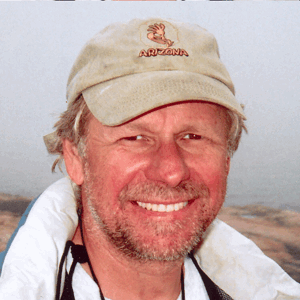
Ian Marshall, professor of English at Penn State Altoona (Photo: Ian Marshall)
MARSHALL: Yep, that's exactly it. In fact, in the epigraph to my book, I took that idea of simplifying – it's the line he has in his first chapter called "Economy" where Thoreau says, "Shall we always study to obtain more of these things and not sometimes to be content with less?" Haiku is all about being content with less, because it's so few words and it's so, so short, and so small, and so simple, and yet there's something magnificent about those few simple words.
YOUNG: Can you read us a haiku that you extracted from the "Economy" section of "Walden"?
MARSHALL: No curtains
No gazers to shut out
But the sun and the moon.
YOUNG: Mm hmm.
MARSHALL: So he lived in his cabin, he didn't need any curtains because there's nobody around but the sun and the moon.
YOUNG: There's also this notion that solitude is important in haiku.
MARSHALL: Absolutely, the Japanese term for that is sabi – s-a-b-i – and of course, Thoreau has a chapter called "Solitude" and in the Japanese principle, it's sometimes translated as aloneness. And there's something melancholy about that, but there's also something beautiful because it's in moments when we're alone in a natural world that we may most be attuned to the beauty of the natural world.
YOUNG: And in many cases, the source material from "Walden," it's not that far away from the haiku that you crafted from it. I mean he was really close to haiku in some moments, in some descriptions, wasn't he?
MARSHALL: Oh, absolutely. It's because he thought that the stuff of the natural world was worth observing closely, and worth commenting on, and worth recording. And I think, like a haiku writer, they sense that we don't need to explain a whole lot, we just need to present it. And often in haiku you juxtapose two images, you set them next to each other and let them reverberate.
YOUNG: I was hoping you could give us a couple of the poems along with the excerpts from the original, from "Walden"?
MARSHALL: Sure. Here's one from Spring:
The first sparrow
Faint silvery warblings
Over bare fields.
And that seems to me the essence of that whole chapter on spring, it's the excitement! And here's the original:
"The first sparrow of spring! The year beginning with younger hope than ever. The faint, silvery warblings heard over the partially bare and moist fields from the bluebird, the song sparrow, and the redwing as if the last flakes of winter tinkled as they fell."
So you can see, I cut out stuff, but the bits I used were all there in a couple of sentences by Thoreau. So, I'm essentially stealing from him! [Laughs]
YOUNG: [Laughs] I think it's called an homage.
MARSHALL: [Laughs] Right, and I'm giving him credit.
YOUNG: Yeah, oh, sure. Professor, you also found parallels here between what Thoreau was doing at Walden and what a Japanese haiku master Basho did at a pond a century earlier.

Professor’s Marshall’s new book that rewrites Thoreau’s Walden in haiku form. (Photo: Ian Marshall)
MARSHALL: Basho was probably the most famous haiku writer of all, perhaps the most famous writer in Japanese literature. And interestingly enough probably his most famous haiku is about a pond, and of course "Walden" is about Thoreau living by the side of a pond. Basho's haiku about the pond is:
The old pond
A frog jumps
The sound of water
The point for Basho was – among many possible points – is that this is the moment when he realized haiku doesn't have to be about the spectacular, it doesn't have to be about a magnificent mountain vista or a waterfall. It can be something as simple as an old pond and a frog jumping, and in that simplicity, in that attunement to taking in the simplicity of the natural world, that's where the beauty of a haiku comes.
YOUNG: It is remarkable, these two writers, two poets separated by an ocean, a language, more than a century in time, and yet they arrived at very similar ways of trying to describe nature.
MARSHALL: Yeah, and it's about paying attention. I actually do a haiku lesson in an environmental studies class that I team-teach with a biologist. And we're interested in tracing – gee, what connections can there be between poetry and biology.
And one thing we talk about in reference to haiku is that just as a scientist begins, even before a scientist constructs a hypothesis, begins with just observing: What do you see?
Well, that's where a poet begins, too. So, you begin before you decide what things mean, you begin by observing. Why do people like Basho and Thoreau have something similar in the way that they look at the natural world? I think because they paid attention and they delighted in the attention they paid to the natural world.
YOUNG: Do you have a favorite from your haikus?
MARSHALL: Oh, I've got a bunch of them actually. Here's one from "The Bean Field":
Tonight
My flute has waked echoes
Over the pond
Here's another one, it's kind of sad and lonely, but it's also – there's something very beautiful. You wonder about those echoes, is it memories; is it a yearning for a friend, a companion?
We don't know, but it's just this beautiful sort of melancholy image.
YOUNG: Have you visited Walden Pond?
MARSHALL: Yeah, yeah.
YOUNG: You know, my experience there is there's a strong sense of irony. When you go there, especially if you happen to visit on a warm weekend in the summer. It's thick with people the path is fenced off, so that you actually can't get to the pond. It's ain't like Thoreau saw it.
MARSHALL: [Laughs] That's for sure. Yeah, my initial impression when I got there was, you know, "Holy crap, what have they done to this place?" I mean look at all the people! Smell all the suntan oil.
But, I also found once you leave the public beach and start making your way around the pond, by the time you get to the other side I think I saw a birdwatcher or two, took a swim with some ducks. So, you just move away from the public beach and you can experience some of the solitude Thoreau might have felt there.
YOUNG: What do you think Henry David Thoreau might make of your book?
MARSHALL: [Laughs] Well, he was a pretty cantankerous guy, we understand. I hope he would be pleased that someone was so interested in what he had to say that they wanted to dwell on his words to this extent – to shape it into a different literary form. But, I imagine he would have been sympathetic to the goals of haiku and to the practice of haiku. People often say that his poetry wasn't as wonderful as his prose. If he'd had access to haiku, if he'd known about haiku maybe that would have been his poetic genre.
YOUNG: Professor Ian Marshall, the book is called "Walden by Haiku." Thank you very much for your time.
MARSHALL: Oh, thank you.
Related link:
To learn more about Professor Ian Marshall’s work, visit his webpage.
[MUSIC: Jeremy Pelt “Haiku” from “Identity” (Max Jazz Records 2005)]
YOUNG: You can hear our program anytime on our website, or get a download for your MP3 player- the address is loe dot org- that’s loe dot org. There you’ll also find pictures and more information about our stories. And we’d like to hear from you. You can reach us at comments at loe dot org- once again that’s comments at loe dot org. Our postal address is 20 Holland Street, Somerville, Massachusetts 02144. And you can call our listener line at 800-218-9988.
We leave you this week underwater in the Southern Hemisphere.
[SOUND OF RIGHT WHALES]
YOUNG: There’s nothing wrong with this right whale. At least Roger Payne doesn’t think so. But the renowned whale scientist was a bit perplexed by the sounds made by this lone adult. Payne recorded the whale with a hydrophone he placed at the bottom of the sea near Peninsula Valdez in Argentina.
[SOUND OF RIGHT WHALES]
Living on Earth is produced by the World Media Foundation. Our crew includes Bobby Bascomb, Eileen Bolinsky, Bruce Gellerman, Ingrid Lobet, Helen Palmer, Jessica Ilyse Smith, Ike Sriskandarajah, and Mitra Taj, with help from Sarah Calkins, and Sammy Sousa.
Our interns are Amanda Martinez, Meghan Miner and Ami Ninh. Jeff Turton is our technical director. Alison Lirish Dean composed our themes. Steve Curwood is our executive producer. You can find us anytime at loe dot org – and check out our facebook page – PRI’s Living on Earth. I’m Jeff Young.
Thanks for listening.
ANNOUNCER: Funding for Living On Earth comes from the National Science Foundation supporting coverage of emerging science. And Stonyfield farm, organic yogurt and smoothies. Stonyfield pays its farmers not to use artificial growth hormones on their cows. Details at Stonyfield dot com. Support also comes from you, our listeners. The Ford Foundation, The Town Creek Foundation, The Oak Foundation—supporting coverage of climate change and marine issues. And Pax World Mutual Funds, integrating environmental, social, and governance factors into investment analysis and decision making. On the web at Pax world dot com. Pax World for tomorrow.
ANNOUNCER 2: PRI – Public Radio International
Living on Earth wants to hear from you!
Living on Earth
62 Calef Highway, Suite 212
Lee, NH 03861
Telephone: 617-287-4121
E-mail: comments@loe.org
Newsletter [Click here]
Donate to Living on Earth!
Living on Earth is an independent media program and relies entirely on contributions from listeners and institutions supporting public service. Please donate now to preserve an independent environmental voice.
NewsletterLiving on Earth offers a weekly delivery of the show's rundown to your mailbox. Sign up for our newsletter today!
 Sailors For The Sea: Be the change you want to sea.
Sailors For The Sea: Be the change you want to sea.
 The Grantham Foundation for the Protection of the Environment: Committed to protecting and improving the health of the global environment.
The Grantham Foundation for the Protection of the Environment: Committed to protecting and improving the health of the global environment.
 Contribute to Living on Earth and receive, as our gift to you, an archival print of one of Mark Seth Lender's extraordinary wildlife photographs. Follow the link to see Mark's current collection of photographs.
Contribute to Living on Earth and receive, as our gift to you, an archival print of one of Mark Seth Lender's extraordinary wildlife photographs. Follow the link to see Mark's current collection of photographs.
 Buy a signed copy of Mark Seth Lender's book Smeagull the Seagull & support Living on Earth
Buy a signed copy of Mark Seth Lender's book Smeagull the Seagull & support Living on Earth

